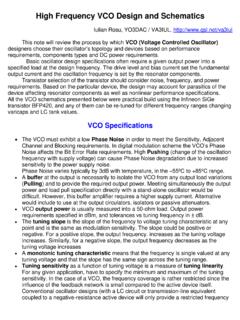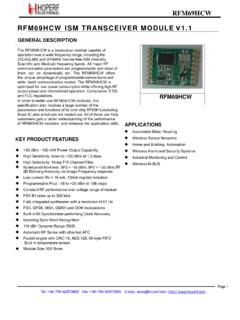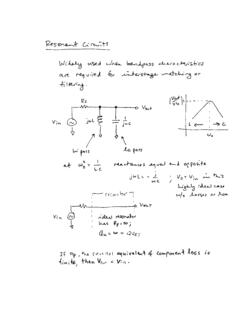Transcription of MMCM and PLL Dynamic Reconfiguration Application Note
1 XAPP888 ( ) August 20, 1 SummaryThis Application note provides a method to dynamically change the clock output frequency, phase shift, and duty cycle of the mixed-mode clock manager (MMCM) for the Xilinx 7 series, UltraScale , and UltraScale+ FPGAs. Similarly, the phase- locked loop (PLL) can be changed through the Dynamic Reconfiguration port (DRP). An explanation of the behavior of the internal DRP control registers is accompanied by a reference design that uses a state machine to drive the DRP, which ensures the registers are controlled in the correct the reference design performs the operations for the user, familiarity with the functional operation of the MMCM is recommended. For more information on MMCM and PLL functionality, see the 7 Series FPGA Clocking Resources User Guide (UG472) and the UltraScale Architecture Clocking Resources User Guide (UG572).The reference design supports two Reconfiguration state addresses and can be extended to support additional states. Each state does a full Reconfiguration of the MMCM or PLL so that most parameters can be changed.
2 The design does not support outputs configured with fine-phase shifting can download the reference design files for this Application note from the Xilinx website. For detailed information about the design files, see Reference Application note describes the information necessary to reconfigure the MMCM or PLL and provides a reference design that implements all of the algorithms covered. The PLL and MMCM share very similar functionality but are not identical. Due to some subtle functionality differences and the requirement for different settings, a separate PLL reference design is provided. To ensure correct operation, use the correct reference design for the clock management tile (CMT) being reconfigured. Furthermore, there are differences in attributes and frequency specifications for the various families. Consult the appropriate user guide and data sheet for the selected device is performed through the DRP. The DRP provides access to the configuration bits that would normally only be initialized in the bitstream.
3 This allows the user to dynamically change the MMCM or PLL clock outputs without loading a new bitstream. The MMCM or PLL must be held in reset during Dynamic Reconfiguration or must be reset after the Dynamic Reconfiguration changes have completed. Frequency, phase, and duty cycle can all be changed Application Note: 7 Series, UltraScale, and UltraScale+ FPGAsXAPP888 ( ) August 20, 2019 MMCM and PLL Dynamic ReconfigurationAuthor: Jim TatsukawaMMCM and PLL Configuration Bit GroupsXAPP888 ( ) August 20, 2through the DRP port. Fine-phase shifting is not allowed for the initial configuration or during MMCM and PLL Configuration Bit Groups section presents the configuration bits as five bit groups, and provides an overview of their usage. The DRP Registers section details the configuration bit locations as registers. This information is not necessary to use the DRP reference design ; it is intended to give an overview of the internal MMCM attributes that must be changed along with their register locations.
4 Specific information on how the attributes are calculated is provided through the reference design . The reference design functionality and use are explained in the Reference design and Using the Reference design and PLL Configuration Bit GroupsThe MMCM has six user-accessible configuration bit groups that allow Reconfiguration of individual clock outputs. The six groups are the divider group, the phase group, the fractional group, the lock group, the filter group, and the power group. These configuration bit groups are internal to the MMCM primitive and clarify the operation of the MMCM_DRP reference design module. The user modifiable parameters for the MMCM_DRP module are described in the Reconfiguration Module Ports and Attributes GroupEvery clock output has a divider group associated with it. The divider group is composed of the following parameters: High Time Low Time No Count EdgeThe first two parameters associated with the divider group are the High and Low Time counters.
5 These counters set the number of voltage-controlled oscillator (VCO) clock cycles through which the output clock should stay High or Low. For example, if you set both High and Low Time to 2, the effective divide value is 4 and the duty cycle is 50%.The No Count parameter disables the High and Low Time counters. This in turn makes the divider output a clock with an effective divide value of Edge parameter controls the High to Low transition. It forces the High Time counter to transition on a falling edge at the end of its count. This has the effect of increasing the High Time while decreasing the Low Time. Another way to think of the edge bit is that it adds half a VCO clock cycle to the High Time and subtracts half a clock cycle from the Low an example, if a 50/50 duty cycle is desired with a divide value of 3, the Edge bit would be set. The High Time counter would be set to one and the Low Time counter would be set to 2. With the edge bit set, the net count for the High and Low times would be clock cycles and PLL Configuration Bit GroupsXAPP888 ( ) August 20, 3 Phase GroupEach clock output except the DIVCLK has a phase group associated with it.
6 This group is composed of the following set of parameters: Phase MUX Delay Time MXThe Phase MUX selects a coarse phase from the VCO for a clock output with a resolution of 45 (360 /8) relative to the VCO clock period. Delay Time is a counter that counts the number of VCO clock cycles to delay the output. This means that there is a direct correlation between the possible phase shift for the clock output and the divide value for that particular output. As the divide value increases, finer phase shift steps are available. The Delay Time counter allows for a phase offset of up to 64 VCO clock must be set to 2'b00 during Reconfiguration , regardless of the previous value. This parameter ensures the desired phase is output as GroupThe MMCM supports fractional (non-integer) values for the CLKOUT0 and CLKFBOUT counters. When using fractional values, CLKOUT0 and CLKFBOUT add the following parameters: FRAC_EN (For fractional values of CLKOUT0 or CLKFBOUT) FRAC (For fractional values of CLKOUT0 or CLKFBOUT) PHASE_MUX_F (For fractional values of CLKOUT0 or CLKFBOUT) FRAC_WF_R (For fractional values of CLKOUT0 or CLKFBOUT) FRAC_WF_F (For fractional values of CLKOUT0 or CLKFBOUT)FRAC_EN enables the fractional circuitry.
7 When enabling the fractional counters, parameters for the divider group and phase group must be FRAC parameter represents the fractional divide portion of the divider in increments. For example FRAC(4) = is the coarse phase for the falling edge with a resolution of 45 relative to the VCO clock period. PHASE_MUX_F is additionally used with the Low Time and High Time parameters to adjust the duty cycle. For odd fractional divide values ( , or ), an exact 50% duty cycle is not possible, resulting in a duty cycle that is off by 1/8 VCO and FRAC_WF_F adjust internal MMCM timings required for fractional PHASE_MUX_F and FRAC_WF_F parameters for CLKOUT0 are located in ClkReg2 for CLKOUT5 (see Table 5). The fractional settings for CLKOUT0 do not affect CLKOUT5. Similarly, DRP RegistersXAPP888 ( ) August 20, 4the PHASE_MUX_F and FRAC_WF_F parameters for CLKFBOUT do not affect CLKOUT6 (see Table 6).Lock GroupThis group cannot be calculated with an algorithm and is based on lookup tables created from device characterization.
8 The appropriate lock bit settings are dependent on the feedback divider setting. This divider is set with the CLKFBOUT_MULT attribute when instantiating the MMCM_DRP module. The lock group has an effect on the MMCM's ability to detect that it is locked . The lookup table is located in the reference design within GroupThis group cannot be calculated and is based on lookup tables created from device characterization. There are effectively two tables, one for each bandwidth setting. The feedback divider setting (CLKFBOUT_MULT) acts as the index to the chosen table. There are three bandwidth settings allowable in the tools (High, Low, and Optimized), but in effect there are only two. High and Optimized use the same table, while the Low bandwidth setting uses a separate table. The filter group has an effect on the phase skew and the jitter filtering capability of the MMCM. The lookup table is located in the reference design within GroupThis group allows the Dynamic Reconfiguration operations to properly function.
9 The bits associated with this group must be all enabled when performing RegistersFor the MMCM seventeen configuration registers store the divide and phase bit groups. For each of the eight clock outputs (CLKOUT[6:0] and CLKFBOUT) there are two configuration registers for a total of sixteen. These 16 registers represent the O[6:0] and M in Figure 1. One additional register is associated with DIVCLK_DIVIDE, which is along the input path to the MMCM. DIVCLK_DIVIDE is shown in Figure 1 as D. DRP RegistersXAPP888 ( ) August 20, 5 The PLL is organized similar to the MMCM with exceptions noted in the Figure 1 block diagram and in the subsequent sixteen registers that have the same layout are divided into two registers CLKREG1 and CLKREG2. The register layout for CLKREG1 and CLKREG2 are shown in Table 1 through Table 7. The register layouts are shown in Table 1 through Table Target - Figure 1 Figure 1:MMCM and PLL Block DiagramDClockSwitchCircuitPFDLock DetectLockLock MonitorCLKIN1 GeneralRoutingCLKIN2 CLKFBCLKFBOUTCLKOUT6 (MMCM only)CLKOUT5 CLKOUT4 CLKOUT3B (MMCM only)CLKOUT3 CLKOUT2B (MMCM only)CLKOUT2 CLKOUT1B (MMCM only)CLKOUT1 CLKOUT0B (MMCM only)CLKOUT0 CLKFBOUTB (MMCM only)CPLFVCO9O0MO1O2O3O4O5O6x888_01_1222 118-Phase Taps + 1 Variable Phase TapTable 1: ClkReg1 Bitmap for CLKOUT[6:0] and CLKFBOUTClkReg1 7 Series Bit UltraScale BitDescriptionPHASE MUX [15:13][15:13]Chooses an initial phase offset for the clock output, the resolution is equal to 1/8 VCO period.
10 Not available in UltraScale PLLE3 and UltraScale+ [12][12]Retain the previous value stored TIME[11:6][11:6]Sets the amount of time in VCO cycles that the clock output remains TIME[5:0][5:0]Sets the amount of time in VCO cycles that the clock output remains RegistersXAPP888 ( ) August 20, 6 Table 2: ClkReg2 Bitmap for CLKOUT[0]ClkReg2 7 Series Bit UltraScale BitDescriptionRESERVED[15][15] [14:12][14:12]Fractional divide counter setting for CLKOUT0. Equivalent to additional divide of 1 [11][11]Enable fractional divider circuitry for [10][10]Adjusts CLKOUT0 rising edge for improved duty cycle accuracy when using fractional [9:8][9:8]Must be set to 2' [7][7]Chooses the edge that the High Time counter transitions COUNT[6][6]Bypasses the High and Low Time TIME[5:0][5:0]Phase offset with a resolution equal to the VCO 3: ClkReg2 Bitmap for CLKOUT[1]ClkReg2 7 Series Bit UltraScale BitDescriptionRESERVED[15:10][15]Retain the previous value stored [14:13]For the PLLE3 and PLLE4, determines CLKPHYOUT frequency based on the VCO [12:11] Retain the previous value stored [10]Reserved for [9:8][9:8]Must be set to 2' [7][7]Chooses the edge that the High Time counter transitions COUNT[6][6]Bypasses the High and Low Time TIME[5:0][5:0]Phase offset with a resolution equal to the VCO 4: ClkReg2 Bitmap for CLKOUT[4:2]ClkReg2 7 Series Bit UltraScale BitDescriptionRESERVED[15:10][15.]















